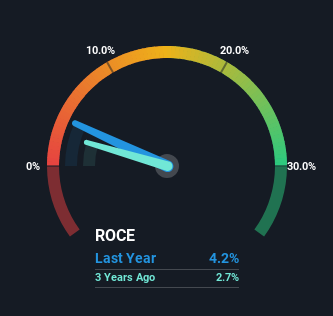- Belgium
- /
- Consumer Durables
- /
- ENXTBR:BELYS
The Returns On Capital At Belysse Group (EBR:BELYS) Don't Inspire Confidence
Ignoring the stock price of a company, what are the underlying trends that tell us a business is past the growth phase? Typically, we'll see the trend of both return on capital employed (ROCE) declining and this usually coincides with a decreasing amount of capital employed. This combination can tell you that not only is the company investing less, it's earning less on what it does invest. And from a first read, things don't look too good at Belysse Group (EBR:BELYS), so let's see why.
Return On Capital Employed (ROCE): What Is It?
For those that aren't sure what ROCE is, it measures the amount of pre-tax profits a company can generate from the capital employed in its business. To calculate this metric for Belysse Group, this is the formula:
Return on Capital Employed = Earnings Before Interest and Tax (EBIT) ÷ (Total Assets - Current Liabilities)
0.042 = €11m ÷ (€334m - €74m) (Based on the trailing twelve months to June 2023).
So, Belysse Group has an ROCE of 4.2%. In absolute terms, that's a low return and it also under-performs the Consumer Durables industry average of 10%.
Check out our latest analysis for Belysse Group

Above you can see how the current ROCE for Belysse Group compares to its prior returns on capital, but there's only so much you can tell from the past. If you're interested, you can view the analysts predictions in our free report on analyst forecasts for the company.
What Can We Tell From Belysse Group's ROCE Trend?
The trend of ROCE at Belysse Group is showing some signs of weakness. The company used to generate 5.8% on its capital five years ago but it has since fallen noticeably. In addition to that, Belysse Group is now employing 56% less capital than it was five years ago. The combination of lower ROCE and less capital employed can indicate that a business is likely to be facing some competitive headwinds or seeing an erosion to its moat. Typically businesses that exhibit these characteristics aren't the ones that tend to multiply over the long term, because statistically speaking, they've already gone through the growth phase of their life cycle.
The Bottom Line On Belysse Group's ROCE
In summary, it's unfortunate that Belysse Group is shrinking its capital base and also generating lower returns. We expect this has contributed to the stock plummeting 80% during the last five years. Unless there is a shift to a more positive trajectory in these metrics, we would look elsewhere.
Belysse Group does have some risks, we noticed 2 warning signs (and 1 which shouldn't be ignored) we think you should know about.
While Belysse Group isn't earning the highest return, check out this free list of companies that are earning high returns on equity with solid balance sheets.
Valuation is complex, but we're here to simplify it.
Discover if Belysse Group might be undervalued or overvalued with our detailed analysis, featuring fair value estimates, potential risks, dividends, insider trades, and its financial condition.
Access Free AnalysisHave feedback on this article? Concerned about the content? Get in touch with us directly. Alternatively, email editorial-team (at) simplywallst.com.
This article by Simply Wall St is general in nature. We provide commentary based on historical data and analyst forecasts only using an unbiased methodology and our articles are not intended to be financial advice. It does not constitute a recommendation to buy or sell any stock, and does not take account of your objectives, or your financial situation. We aim to bring you long-term focused analysis driven by fundamental data. Note that our analysis may not factor in the latest price-sensitive company announcements or qualitative material. Simply Wall St has no position in any stocks mentioned.
About ENXTBR:BELYS
Belysse Group
Manufactures and sells textile floor coverings for commercial and residential applications in Europe, North America, and internationally.
Undervalued with moderate growth potential.
Market Insights
Community Narratives



